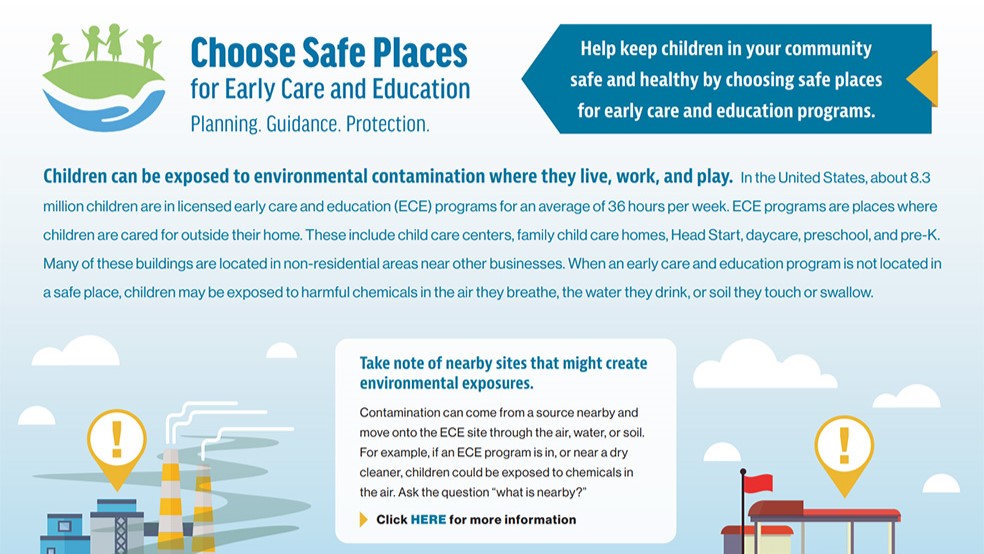Purpose
The Choose Safe Places for Early Care and Education Toolkit: Exposure Pathways Infographic is a shareable tool that provides information on ways children might be exposed to environmental contamination.
Exposure Pathways Infographic
Children can be exposed to environmental contamination where they live, work, and play. In the United States, about 8.3 million children are in licensed early care and education (ECE) programs. These children are in these programs for an average of 36 hours per week. ECE programs are places where children are cared for outside their home. These include child care centers, family child care homes, Head Start, daycare, preschool, and pre-K. Many of these buildings are located in non-residential areas near other businesses. When an early care and education program is not located in a safe place, children may be exposed to harmful chemicals. They may be exposed by the air they breathe, the water they drink, or soil they touch or swallow.
Take note of nearby sites that might create environmental exposures.
Contamination can come from a source nearby and move onto the ECE site through the air, water, or soil. For example, what if an ECE program is in, or near a dry cleaner. Children could be exposed to chemicals in the air. Ask the question “what is nearby?”
Protect children by making sure the drinking water is safe.
Safe drinking water is critical for the health and well-being of children and staff in an ECE program. Contaminants can get into drinking water from a variety of sources, activities, or problems. For example, chemicals for cleaning metal parts or in the dry-cleaning of clothes could be spilled and soak into the groundwater. This contaminated groundwater can get into buildings as vapor, or it could get into the drinking water supply.
Think about naturally occurring hazards that might be in the soil, water, or air.
Human activities sometimes create conditions allowing exposure to a naturally occurring contaminant. For example, a mining operation might disturb naturally occurring contaminants in soil and rock. Rainwater might then wash contaminants such as lead out of exposed piles of soil and rock. Naturally occurring hazards can be just as dangerous as other hazards.
Consider past uses of a site that could create contamination.
Ask the question – what was on this site in the past? Even if a site looks clean, it might not be free of chemical hazards. Past uses of the building might not be obvious. For example, ATSDR once worked with a child care center that unknowingly opened in a former mercury thermometer building. Protect children in ECE programs by considering what was on the site before.
For more information about ATSDR’s Choose Safe Places program, visit our website.
Note nearby sites that might create environmental exposures
Contamination can come from a source nearby and move onto the ECE site through the air, water, or soil. For example, what if an ECE program is in, or near a dry cleaner. Children could be exposed to chemicals in the air. Ask the question “what is nearby?”


